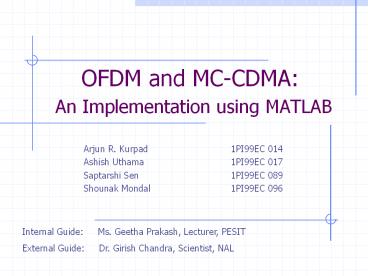OFDM and MCCDMA: An Implementation using MATLAB - PowerPoint PPT Presentation
1 / 23
Title:
OFDM and MCCDMA: An Implementation using MATLAB
Description:
Predicted technique in fourth Generation (4G) mobile phones ... Tandem development of Tx and Rx. The Modules. Modulator module: BPSK, QPSK, 8QAM. Channel module: ... – PowerPoint PPT presentation
Number of Views:1395
Avg rating:3.0/5.0
Title: OFDM and MCCDMA: An Implementation using MATLAB
1
OFDM and MC-CDMA An Implementation using MATLAB
- Arjun R. Kurpad 1PI99EC 014
- Ashish Uthama 1PI99EC 017
- Saptarshi Sen 1PI99EC 089
- Shounak Mondal 1PI99EC 096
Internal Guide Ms. Geetha Prakash, Lecturer,
PESIT External Guide Dr. Girish Chandra,
Scientist, NAL
2
Motivation
- High transmission rates over wireline and
wireless channels with protection from multipath
fading - Predicted technique in fourth Generation (4G)
mobile phones - Ideal for bandwidth hogging applications like
Video Conferencing, DAB, DVB, etc - Multiuser capacity possible using MC-CDMA
3
Objectives
- Simulation of a baseband communication system
using OFDM - Using this system to transfer files between
computers using the sound card - Simulation of wireless environment using fading
channels - Multi-User Capability using MC-CDMA
- Plotting of BER curves and constellations
4
Advantages of OFDM
- Allows carriers to overlap (no guard band),
resulting in lesser wasted bandwidth without any
Inter Carrier Interference (ICI) - High data rate distributed over multiple carriers
resulting in lower symbol rate (more immune to
ISI) - Permits higher data rate as compared to FDM
- Increased security and bandwidth efficiency
possible using CDMA OFDM (MC-CDMA) - Simple guard intervals make the system more
robust to multipath effects.
5
What is OFDM ??Orthogonality in time domain
6
What is OFDM ??Orthogonality in frequency domain
- Each carrier is modulated using BPSK / QPSK /
M-ary QAM - Frequency response for each carrier is a Sinc(X)
- Overlap of frequency response is possible as
against FDM where inter-carrier spacing is a must - Frequency responses of the carriers overlap at
zero crossings avoiding Inter Carrier
Interference
7
OFDM Methodology
8
Understanding Multipath
9
Why we need the Guard Period
10
Equalization
- Performed in frequency domain
- FFT compulsorily performed in Receiver
- Time domain convolution replaced with frequency
domain multiplication computationally simpler
code - Adaptive filters used
11
Multicarrier Code Division Multiple Access
(MC-CDMA)
- Combination of CDMA-OFDM to provide multi user
capability - Frequency Diversity avoids deep fades
- Simple receiver structure
12
MC-CDMA Transmitter
13
MC-CDMA Receiver
14
Design and Implementation
- The Environment
- Windows OS
- MATLAB (R12) Toolboxes
- The design approach
- Modular
- Tandem development of Tx and Rx
15
The Modules
- Modulator module
- BPSK, QPSK, 8QAM
- Channel module
- AWGN, Fading, Physical
- Equalizer module
- MC-CDMA module
16
The Physical Channel
- Separate channel module
- Uses DAC/ADC capacity of the sound card
- Unique synchronization scheme
- Time synchronization
- Gain correction
17
The Physical Channel
18
Results
- Constellation diagrams
- Performance of Physical channel
- BER curves for various combinations
19
Constellation diagram
20
BER Curve
21
Screen Shots
- SS1.bmp
22
Applications
- PC to PC file transfer using the ubiquitous sound
card - Digital audio broadcasting (DAB), wireless
CD-quality sound transmission - Digital video broadcasting (DVB), specifically,
digital terrestrial television broadcasting
(DTTB) - Wireless LAN 802.11a
- ADSL (asymmetric digital subscriber line), also
called DMT (Digital Multi Tone)
23
Demonstration of the OFDM system































